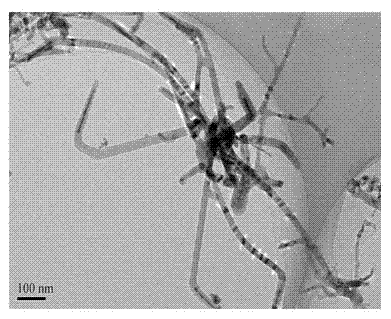Method for preparing precious metal gold particle catalytically-grown stannic oxide nanowire
A noble metal and tin oxide technology, applied in the field of catalysis, can solve problems such as unsatisfactory performance, and achieve the effects of no need for post-processing, high product purity, and simple equipment and technology
- Summary
- Abstract
- Description
- Claims
- Application Information
AI Technical Summary
Problems solved by technology
Method used
Image
Examples
Embodiment 1
[0022] The precursor solution was formed by ultrasonically dissolving tin tetrachloride pentahydrate and chloroauric acid in absolute ethanol, in which the concentration of tin tetrachloride was 0.2 mol / l, and the molar ratio of Sn to Au was 100:1. The above-mentioned precursor solution is fed into the flame reaction zone with hydrogen / air as the auxiliary flame through a syringe pump and an atomizer at a feed rate of 4ml / min, and the hydrolysis reaction is carried out at a reaction temperature of 1800-2000°C. The total gas flow of hydrogen / air in the reaction flame is 1.8m 3 / h, the volume ratio of hydrogen / air is 1:5. The gaseous tin oxide generated by the hydrolysis reaction in the flame condenses and nucleates and grows along a certain direction under the induction and catalysis of the catalyst Au (VLS mechanism), and finally forms a tin oxide nanowire structure with noble metal gold particles at the tip. The nanowire has a diameter of 10-20 nm and a length of 0.2-0.5 μm....
Embodiment 2
[0024] The precursor solution was formed by ultrasonically dissolving tin tetrachloride pentahydrate and chloroauric acid in absolute ethanol, in which the concentration of tin tetrachloride was 0.1 mol / l, and the molar ratio of Sn to Au was 50:1. The above-mentioned precursor solution is fed into the flame reaction zone with hydrogen / air as the auxiliary flame through a syringe pump and an atomizer at a feed rate of 4ml / min, and the hydrolysis reaction is carried out at a reaction temperature of 1600-1800°C. The total gas flow of hydrogen / air in the reaction flame is 1.2m 3 / h, the volume ratio of hydrogen / air is 1:3. The gaseous tin oxide produced by the hydrolysis reaction in the flame is induced and catalyzed by the catalyst Au, condenses and grows along a certain direction, and finally forms a tin oxide nanowire structure with noble metal gold particles at the tip. The diameter of the nanowire is 10-20nm, length 0.1-1μm. The TEM photograph of the product is as figure ...
Embodiment 3
[0026] The precursor solution was formed by ultrasonically dissolving tin tetrachloride pentahydrate and chloroauric acid in absolute ethanol, in which the concentration of tin tetrachloride was 0.2 mol / l, and the molar ratio of Sn to Au was 250:1. The above-mentioned precursor solution is fed into the flame reaction zone with hydrogen / air as the auxiliary flame through a syringe pump and an atomizer at a feed rate of 4ml / min, and the hydrolysis reaction is carried out at a reaction temperature of 1800-2000°C. The total gas flow of hydrogen / air in the reaction flame is 1.8m 3 / h, the volume ratio of hydrogen / air is 1:5. The gaseous tin oxide produced by the hydrolysis reaction in the flame is induced and catalyzed by the catalyst Au, condenses and grows along a certain direction, and finally forms a tin oxide nanowire structure with noble metal gold particles at the tip. The diameter of the nanowire is 10~30nm, length 0.2~0.5um. The TEM photograph of the product is as imag...
PUM
| Property | Measurement | Unit |
|---|---|---|
| diameter | aaaaa | aaaaa |
| length | aaaaa | aaaaa |
| melting point | aaaaa | aaaaa |
Abstract
Description
Claims
Application Information
 Login to View More
Login to View More - R&D
- Intellectual Property
- Life Sciences
- Materials
- Tech Scout
- Unparalleled Data Quality
- Higher Quality Content
- 60% Fewer Hallucinations
Browse by: Latest US Patents, China's latest patents, Technical Efficacy Thesaurus, Application Domain, Technology Topic, Popular Technical Reports.
© 2025 PatSnap. All rights reserved.Legal|Privacy policy|Modern Slavery Act Transparency Statement|Sitemap|About US| Contact US: help@patsnap.com



